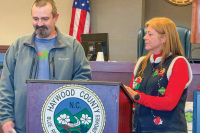Waynesville comes up short in property tax rate cut

During a rare special-called meeting on the morning of June 16, aldermen shaved another 1.5 cents off the proposed ad valorem tax rate but couldn’t quite meet demands from citizens to bring the budget down to a revenue-neutral level, due to long-term ramifications on the town’s emergency savings.
“I’ve been here 25 years and never experienced putting the town in a situation with our fund balance and that kinda scares me,” said Mayor Gary Caldwell.
A county-wide property revaluation earlier this year showed valuations increasing on the order of 20 percent or more for some homeowners. Had the town retained its previous 49.47-cent rate, it would have experienced a massive revenue influx at the expense of property owners.
Initial budget proposals hovered around a new rate of 45.45 cents, but taxpayers voiced concerns at the town’s June 8 regular meeting, saying the lower tax rate would still result in higher — in some cases, much higher — tax bills for residents.
During that meeting, aldermen Chuck Dickson and Jon Feichter directed town staff to prepare a revenue-neutral budget that would bring in about the same amount of revenue as last year and present it during the June 16 meeting.
Finance Director Autumn Lyvers did just that, presenting aldermen with several options — but with several warnings.
Related Items
Aldermen remain reluctant to make spending cuts, especially the $900,000 needed to bring town employee pay closer to a competitive rate, so Lyvers’ new proposals included no decreases in expenditures.
Instead, the proposals center on using a combination of fund balance and hopeful projections of sales tax income to plug the gap. The first option, a revenue-neutral rate of 41.27 cents, would hold disastrous consequences for the town’s fund balance over the next four years. Generally, using fund balance for recurring expenses is a no-no, akin to paying monthly household bills from a savings account. Once it’s gone, it’s gone.
Additionally, the state’s Local Government Commission sets baselines for municipalities in terms of fund balance, expressed as a percent of the government’s yearly general fund. If a municipality experiences sudden and/or drastic changes in fund balance, warnings from the LGC ensue and ultimately the LGC could force the town to raise its tax rate until fund balance levels once again become acceptable.
The town’s fund balance is currently a healthy one at 46.84 percent, slightly above that of towns with similar population sizes, currently 43.31 cents.
Another option presented by Lyvers was what she called, “the lowest rate I can comfortably recommend,” which is 43.92 cents.
Both options leave the town looking to bridge the gap between expenses and income. However, the 43.92-cent rate would necessitate less fund balance utilization. Anything above the revenue-neutral rate of 41.27 cents is a de-facto tax increase on most property owners.
“I’m not in favor of raising taxes this year, which is in essence what we’re doing,” said Dickson, who said he was optimistic that revenue would come in above projections, based on building permit data and debt rolling off the books in the coming years.
Alderman Anthony Sutton made a motion to present the 43.92-cent rate to the public on June 22 (after press time) and hold a vote.
“I feel like we have a responsibility to be good stewards of taxpayer money,” he said, mentioning the impact that a lower fund balance would have on the town’s creditworthiness.
Mayor Pro Temp Julia Freeman seconded the motion, saying she was optimistic but was also concerned about rising gasoline prices and the specter of inflation.
They were opposed by Dickson and Feichter, who continued the push for a revenue-neutral rate. Caldwell cast a rare tie-breaking vote to side with Freeman and Sutton.









